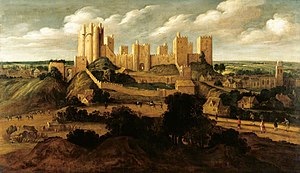Pontefract Castle
The castle, on a rock to the east of the town above All Saints' Church,[1] was constructed in approximately 1070 by Ilbert de Lacy[2] on land which had been granted to him by William the Conqueror as a reward for his support during the Norman Conquest.Thomas, Earl of Lancaster (circa 1278–1322) was beheaded outside the castle walls six days after his defeat at the Battle of Boroughbridge, a sentence placed on him by King Edward II himself in the great hall.In the closing years of the 14th century, Richard II banished John of Gaunt's son Henry Bolingbroke, Duke of Hereford, from England.Shakespeare's play Richard II (Act 2, scene 1, 277) relates Bolingbroke's homecoming in the words of Northumberland in the speech of the eight tall ships:-Then thus: I have from Port Le Blanc, A bay in Brittany, receiv'd intelligence, That Harry Duke of Herford, Rainold Lord Cobham, Thomas, son and heir to th' Earl of Arundel, That late broke from the Duke of Exeter, His brother, Archbishop late of Canterbury, Sir Thomas Erpingham, Sir John Ramston, Sir John Norbery, Sir Robert Waterton, and Francis Quoint— All these, well furnished by the Duke of Brittany With eight tall ships, three thousand men of war, Are making hither with all due expedience, And shortly mean to touch our northern shore When Bolingbroke landed at Ravenspur on the Humber, he made straight way for his castle at Pontefract.King Henry VIII of England stayed at the castle arriving on 23 August 1541 during his summer royal progress of the North.It was alleged during his visit that Henry VIII's fifth wife, Catherine Howard, committed her first act of adultery with Sir Thomas Culpeper at Pontefract Castle, for which she was later apprehended and beheaded at the Tower of London without trial.[8] On his way south to London, King James rode from Grimston Park to view Pontefract Castle on 19 April 1603 and stayed the night at the Bear Inn at Doncaster.Charles I was executed in January, and Pontefract's garrison came to an agreement and Colonel Morrice handed over the castle to Major General John Lambert on 24 March 1649.[17] Excavations led by DigVentures in 2019–20 in the castle's drawbridge pit uncovered numerous mason's marks on the structure, as well as lead shot dating to the Civil War.




Pontefract MuseumAlexander KeirincxcastlePontefractWest YorkshireRichard IIEnglish Civil WarIlbert de LacyWilliam the ConquerorNorman ConquestDomesday Surveyde LacyHenry IRoger de LacyRichard IKing JohnCastle DoningtondonjonHouse of LancasterThomas, Earl of LancasterBattle of BoroughbridgePontefract PrioryHenry, Duke of LancasterJohn of GauntEdward IIIRichard IIHenry BolingbrokeTower of LondonWilliam ShakespeareRichard IIIElizabeth WoodvilleRichard GreyAnthony Woodville, 2nd Earl RiversThomas Darcy, 1st Baron Darcy de DarcyPilgrimage of GraceHenry VIIIKing Henry VIII of Englandroyal progressCatherine HowardThomas CulpeperMary, Queen of ScotsJohn LambertKing JamesGrimston ParkAnne of DenmarkRoyalistsMarmaduke Langdale, 1st Baron Langdale of HolmeParliamentarianminingCharles IBattle of NasebyOliver Cromwellslightingcurtain wallposternbarbicansQuatrefoilClifford's TowerChâteau d'Étampestorre albarranaIberian PeninsulaWakefield CounciladministrationYorkshire DayHistoric EnglandDigVenturesdrawbridgeCastles in Great Britain and IrelandList of castles in EnglandPontefract cakesEdmund LodgeThe Yorkshire PostPevsner, NicholasPenguin BooksChequerfieldPontefract BarracksWentbridge House HotelPontefract LibraryPontefract Town HallOld Town Hall, PontefractAll Saints' Church, PontefractSt Giles' Church, PontefractMicklegate Methodist ChurchPontefract Market HallHorsefair flatsThe Black Monk of PontefractPeter of WakefieldConnection to Robin HoodThe de LacysEdmundIlbert, RobertPontefract de Lacys' family treeAckworth SchoolCarleton Community High SchoolKing's SchoolNEW CollegePontefract and District Girls High SchoolSt. WilfridsAlbarrana towersBallot Act 1872First ballot boxBattle of WakefieldThomas DarcyThomas, 2nd Earl of LancasterJohn Morris (soldier)John of PontefractNostell PrioryOsgoldcross WapentakePontefract (UK Parliament constituency)Pontefract and Castleford (UK Parliament constituency)Pontefract FriaryPontefract HermitageRobert WatertonPhilidasValley GardensOsgoldcross Rural DistrictPontefract SouthHenry ArthingtonPercy BarstowRichard BeaumontRichard Benyon De BeauvoirFrederick Handel BoothChristopher BrookeHugh ChildersYvette CooperJoseph Compton-Rickett
